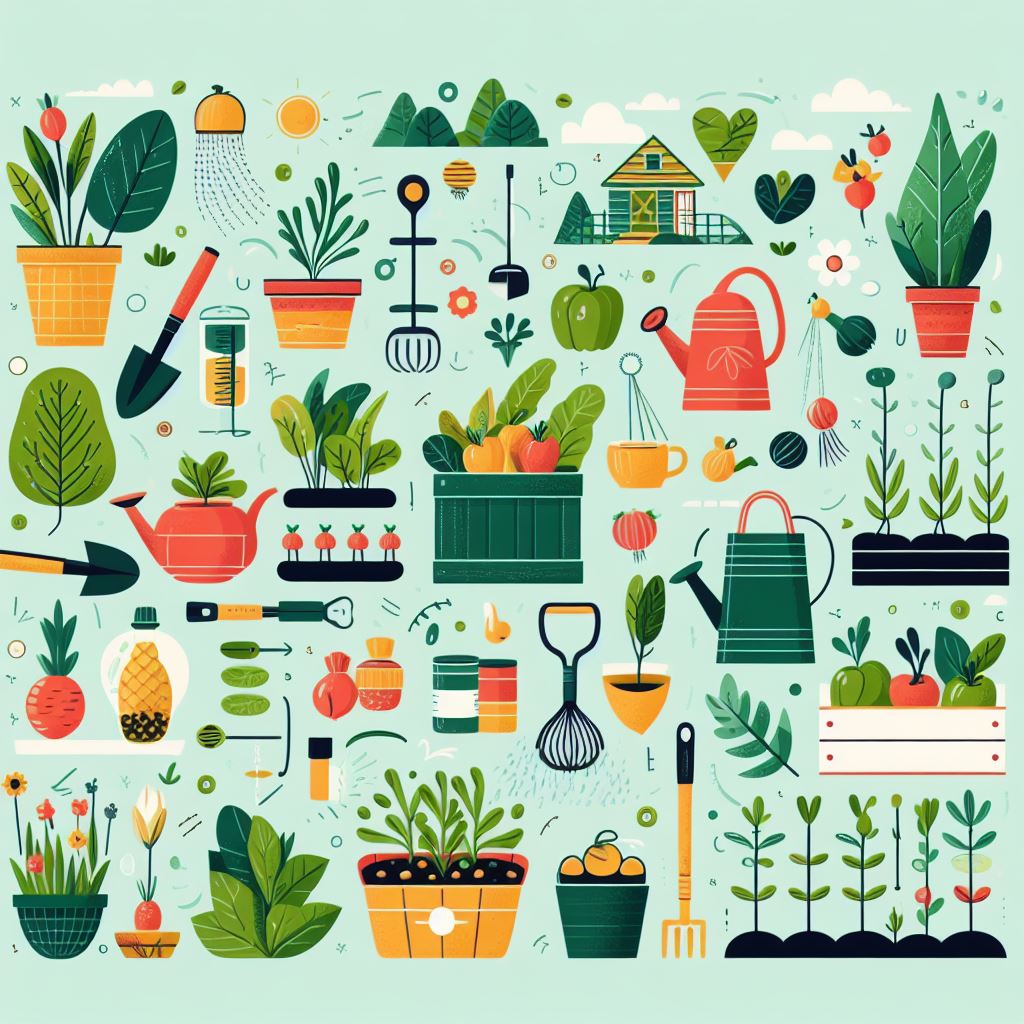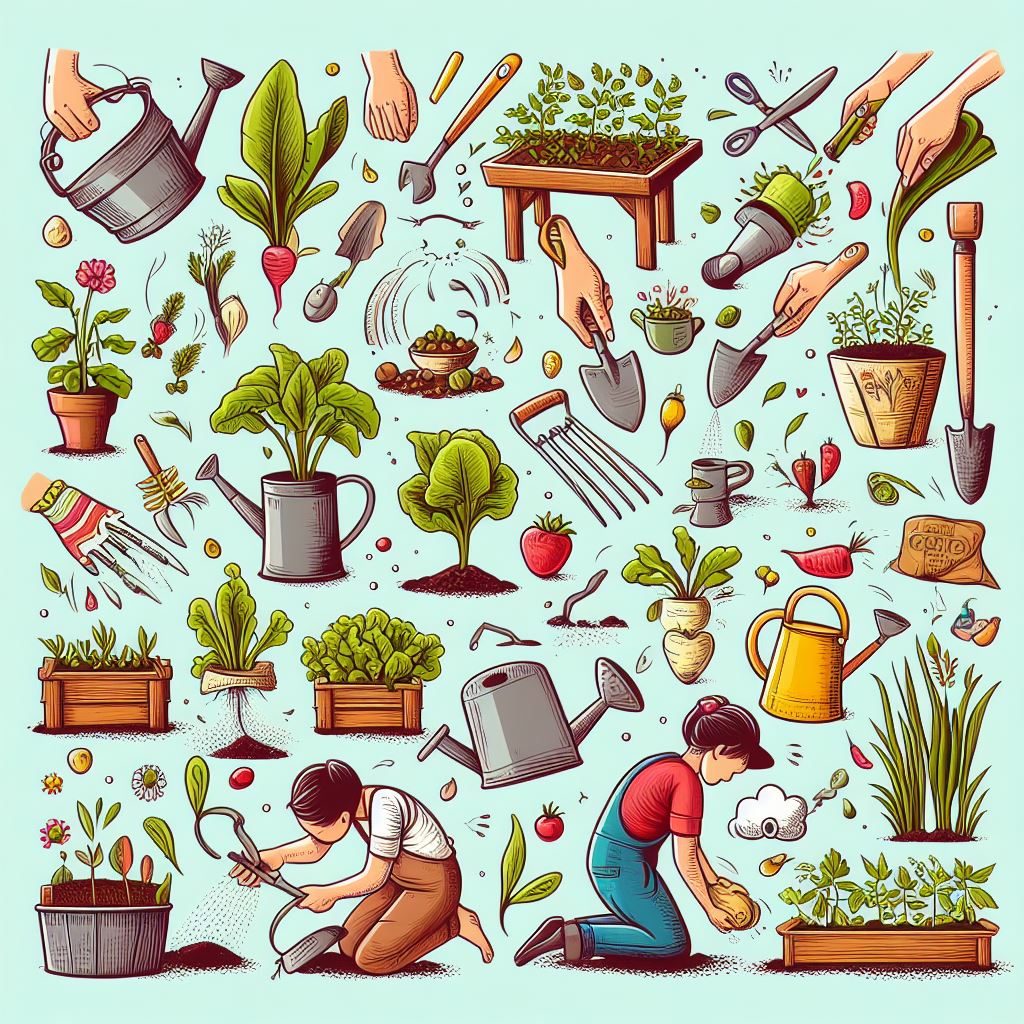Introduction
Gardening with kids provides countless opportunities for fun and learning. In this complete guide, we’ll explore some fascinating gardening fun facts for kids that will get youngsters excited about the great outdoors. From soil secrets to cool botany, these kid-friendly facts make gardening an adventure!
Gardening with kids provides a bounty of fun facts and enriching learning opportunities. As experienced gardeners and mentors, we want to nurture children’s curiosity about the natural world. Let’s dig in to unlock some fascinating secrets hidden in every garden.
Hook – An interesting gardening fact that will capture kids’ attention
Here’s an eye-opening gardening fact: Did you know a single radish seed can produce up to 500 seeds in one season? Radishes grow rapidly, producing edible roots in just 3-4 weeks. Then the radish flowers bloom, resulting in seed pods bursting with hundreds of new seeds! This shows how plants are nature’s endless renewing cycle.
Brief overview of what the article will cover
In this article, we’ll explore more enlightening gardening facts, from soil secrets to clever plant adaptations. We’ll provide tips to get your garden thriving, like choosing the best spot and planning what to plant. Step-by-step guides will show how to plant different types of seeds, care for seedlings, water and weed properly, control pests, and harvest produce.

Fun experiments, crafts, and creative garden projects will let kids get hands-on with gardening. They’ll learn how worms, bees, and other creatures aid the garden. We’ll also share storage tips to enjoy the fruits of your labor. Our goal is to uncover why gardening is so fascinating and teach kids lifelong skills.
Equipped with trowels, curiosity, and some “wow” worthy facts, we’re ready to dig into the world of gardening fun! Let’s grow young gardeners by nurturing their sense of wonder.
Getting Your Garden Ready
Before we plant our first seeds, some garden prep is vital. With good planning and care, we can create an ideal environment where gardens—and young gardeners—will flourish.
Importance of good soil
Soil is the foundation that supports plant life. Healthy soil = healthy plants! Good garden soil contains a blend of sand, silt, and clay along with organic matter like compost. This creates a loose, crumbly texture that provides drainage while retaining moisture and nutrients.
Let’s examine soil closely! Grab a trowel and dig up a sample. What do you see living in the dirt? Worms, beetles, ants, fungi, bacteria, and more! These organisms aerate soil, recycle nutrients, and help plants absorb water and minerals. Was your soil sample dark brown or black? Then it has lots of organic matter like decaying leaves and roots. This is humus—it supports life in the soil food web. Mind those microbes!
Choosing the right spot for your garden
When selecting a site, observe how sunlight hits different areas. Most edible plants need at least 6 hours of direct sunlight daily. Also make sure the area drains well after watering and rainfall. Avoid low spots where puddles collect. Finally, pick a spot near a water source for convenience.
If you have poor native soil, build raised garden beds and fill them with mixed topsoil from your local garden center. Or grow plants in containers using potting mix. This allows control over soil quality.
Planning what to plant
Decide which fruits, veggies, herbs and flowers to grow. Choose varieties suited to your region’s climate and growing season. Group plants with similar light and water needs together. Remember to include fun short-season crops like radishes, lettuces and peas that kids can sow, grow and pick quickly!
With good soil prep, site selection, and planning, our gardens will be primed for planting success. Soon we’ll see sprouts emerge as seeds awakaken below ground. The miracle of growing begins!
Planting Your Seeds and Seedlings
Now for the fun part – planting! Let’s discover techniques for starting seeds and transferring seedlings so our gardens grow successfully.
How to plant different types of seeds
Many seeds can be sown directly in the garden. Shallow trenches work for crops like radishes and peas. Or sprinkle small seeds on the soil surface, then gently press in. Some seeds need light to germinate, so just a dusting of soil covers them.
Follow seed packet instructions for planting depth and spacing. Sow extra seeds since not all will sprout. Cover seeded beds with a thin layer of straw or leaves to retain moisture.
Tip: Presoak large seeds overnight to hasten germination. Place in a jar of water and seeds will plump up, ready to plant!
Caring for seedlings and transplanting them
For tender crops like tomatoes, start seeds indoors in pots 6-8 weeks before your last spring frost date. Gently thin seedlings, keeping the strongest few per pot.
Place pots in a sunny window. Turn them periodically so seedlings don’t bend toward the light. Water when the top inch of soil dries out. As they grow, fertilize lightly with diluted liquid fertilizer or compost tea.
Once seedlings have 4-6 true leaves, it’s time to transplant outdoors! Harden them off first by setting them outside for short periods. Then plant on a cloudy day or late afternoon to avoid transplant shock. Dig holes the width of the root ball, set plants at proper spacing and backfill soil. Shield tender transplants with row covers if frost threatens.
Fun experiments like growing a bean in a plastic bag
How do those hard dry beans sprout into plants? Let kids observe the magical process by growing beans in clear plastic bags. Simply wet a few bean seeds, slip into a sandwich bag of damp cotton balls, and tape to a window.
They’ll witness roots and shoots emerging in days. Have kids record weekly growth measurements and observations in a gardening journal. Transfer bag seedlings to soil once leaves appear.
Experiments make science come alive! What other fun discoveries will we make? Onward to explore more gardening mysteries.
Watering, Weeding, and Caring for Your Garden
Now that our seeds are sprouting, let’s explore hands-on care to keep your garden healthy. Proper watering, weeding, and pest control will reap an abundant harvest!
Tips for proper watering techniques
Plants need adequate water to grow, but overwatering causes problems. Use these tips:
- Water early morning or evening to reduce evaporation
- Thoroughly soak the root zone, don’t just sprinkle the surface
- Let soil dry out between waterings; test with your finger
- Adjust frequency based on weather, plant size and soil type
- Use soaker hoses, drip irrigation or water gently at soil level to avoid fungal disease
- Mulch beds to retain moisture and reduce weeds
Best methods for removing weeds
Vigilant weeding is key! Weeds steal moisture and nutrients from desirable plants. Tackle weeds when small by hand-pulling or hoeing the soil surface. Add mulch to smother weeds and retain moisture. For persistent weeds, use corrugated cardboard or layers of newspaper topped with mulch. This blocks light which weeds need to grow.
Why are weeds so tricky to eradicate? Many propagate from tiny broken root fragments left behind. Patience and persistence pays off in the battle against weeds!
Protecting plants from pests and diseases
Make regular garden patrols to spot pests like aphids and cabbage worms early. Simply spraying with water can dislodge many soft-bodied insects. Encourage natural predators like ladybugs and praying mantises. Using row covers as barriers helps prevent insect damage.
For plant diseases caused by fungi, proper watering and ample spacing improves air circulation. Prune out affected leaves and branches. As a last resort, use organic sprays made with neem oil or essential oils as directed.
Providing good growing conditions is the first line of plant health defense. With astute care and maintenance, your garden will thrive!
Harvesting Your Produce
After patiently tending our gardens, it’s time for the reward – harvesting! Let’s discover optimal times for picking peak ripeness, fun harvesting methods, and how to store our bounty.
Identifying when fruits and veggies are ripe
Timing is everything when harvesting produce at perfect ripeness. Follow these guides:
- Green beans and peas – Plump pods, good color. Beans inside should fill pods.
- Tomatoes – Full color for variety. Slightly soft but not mushy.
- Cucumbers – Dark green, firm, slender. Pick often once set.
- Carrots and beets – Shoulders emerge above ground. Use a fork to loosen soil.
- Leafy greens – Pick outer mature leaves, leaving center to continue growing.
- Melons – Look for color change at blossom end, and stem easily separates.
Fun ways to harvest like picking cherry tomatoes
Make harvesting engaging for kids by letting them:
- Pluck ripe cherry tomatoes off the vine
- Gently tug carrots and radishes from the ground
- Snip beans, peas, greens with kid-sized tools
- Pick flowers to create bouquets for the table
- Forage for ripe raspberries, blueberries, strawberries
Make it a contest to fill baskets quickly! Harvests become more fun shared with others.
Storing your harvest properly
Preserve flavors and nutrients by promptly storing produce after picking:
- Soft fruits should be refrigerated in shallow containers to prevent bruising.
- Leave winter squash and potatoes in a cool, dry spot to cure for longevity.
- Freeze or can excess tomatoes, green beans, and corn.
- Pack carrots, beets, turnips in containers of damp sand in the root cellar.
- Hang herb bunches or dry peppers for storage.
With thoughtful storage methods, we can savor garden-fresh flavors year-round! Our harvest bounty reminds us of the wondrous cycle from seed to fruition.
Gardening Facts and Experiments
Let’s uncover more fascinating science through enlightening gardening facts and hands-on experiments. Discovering how plants grow will inspire budding gardeners.
Interesting facts about soil, seeds, plant growth, etc.
- Healthy soil contains more microorganisms than people on Earth!
- Seeds contain stored food to help baby plants start growing.
- Photosynthesis converts sunlight into plant food using chlorophyll.
- Plants breathe through pores in their leaves called stomata.
- The vascular system carries water and nutrients up the stem and branches.
- Growth happens from the tips back, that’s why pruning promotes bushier plants.
- Flowers contain male and female reproductive parts for pollination.
- Botanically, fruits contain seeds and develop from the ovary.
Simple experiments kids can do like growing sweet potato vines
- Observe roots sprouting by suspending sweet potatoes with toothpicks in water.
- Start seeds in an eggshell instead of a pot, then transplant.
- Grow green bean seeds in wet paper towels sealed in a ziplock bag.
- Compare growth of seeds under different light conditions.
- Try growing plants in different soil types like sand, potting mix and compost.
Documenting predictions and observations in a science journal reinforces learning.
How to make a worm compost bin
Composting with worms lets kids see nature’s recyclers at work! Poke holes in the bottom of a plastic tub. Layer shredded newspaper, leaves, fruit and veggie scraps in the bin, topping with garden soil. Add red wiggler worms from the bait shop and keep mixture moist. Feed them kitchen scraps and they’ll produce nutritious “worm tea” fertilizer for your plants.
Experiencing science first-hand sticks with kids. Get those creative juices flowing on what to try next!
Get Creative in the Garden
Growing plants provides endless inspiration for kids’ creativity to bloom! Gardening and art projects use nature’s beauty.
Crafts using plants and flowers like pressed flowers
Pressed flowers make lovely homemade stationery, bookmarks and notecards. Collect flowers in various stages of bloom. Place between sheets of paper under weights for 1-2 weeks until completely dry.
Create artistic arrangements by layering the fragile pressed blossoms and leaves before gluing to card stock. Write notes to friends explaining the special flowers used.
Make unique seed mosaics by gluing seeds like beans, lentils, rice, coriander in patterns onto cardboard. Spray with sealer for long-lasting garden art.
Making garden signs or decorations
Let kids proudly label the plants they’ve grown by designing fun markers on wooden stakes or paint stirring sticks. Use a marker to write the plant name, then get creative decorating. They can paint, glue buttons or beads, wrap yarn, or tie ribbons to personalize their markers.
Upcycle old garden tools like hoes or rakes into whimsical scarecrows placed in the vegetable patch. Use scrap fabric for clothing and go wild with accessories!
Decorating flower pots and containers
Ordinary containers become extraordinary when customized by kids. Have them paint terra cotta pots with colorful designs – polka dots, stripes, flowers and more. Add flair by gluing or tying ribbons.
For self-watering pots, help drill holes near the base of large plastic soda bottles. Let kids decorate bottles with permanent markers before planting. As soil absorbs water, it wicks up through the bottle’s neck.
The garden itself is a creative canvas. Building birdhouses, drying flowers, making sun prints on paper – go nuts with nature’s artistic potential!
Conclusion
Our journey through the wondrous world of gardening has unearthed many fascinating facts! Let’s recap key lessons learned to spark a lifelong love of gardening in kids.
Summary of main points
We discussed essential preparations like evaluating soil and sunlight to locate the optimal garden site. Planning suitable plants and proper spacing prevents overcrowding.
By progressing through the growing cycle – planting seeds and seedlings, nurturing growth, troubleshooting issues, harvesting produce – kids gain hands-on experience. They observe science and nature firsthand by sprouting beans, watching life teem in compost, and tasting sun-warmed cherry tomatoes.
Fun experiments demonstrate concepts like capillary action, photosynthesis, and decomposition. Getting creative with art and crafts builds a bridge between gardening and imagination.
Inspiring kids to get growing and have fun gardening
An early introduction to gardening instills curiosity about the natural world. Kids gain ownership and pride through planting seeds and tending plants. Making improvements each season teaches perseverance.
Gardening develops skills like responsibility, problem-solving, and work ethic. And nothing beats biting into a juicy, vine-ripened vegetable you grew yourself!
As mentors, we can nurture this sense of wonder in children. Their bright ideas will blossom just like spring flowers. Our goal is to cultivate their confidence so they can spread roots and flourish.
Let’s continue planting seeds – both literally and metaphorically – to help our gardeners grow. When we approach gardening with creativity and curiosity, we see life anew.
FAQs The Ultimate Guide to Gardening Fun Facts for Kids
Gardening with kids can raise many questions for parents and teachers. Below are answers to some frequently asked questions about getting started with gardening fun facts for kids.
To make gardening an enriching, positive experience for children, it’s helpful to learn more about age-appropriate activities, safety precautions, and ways to pique their interest. This FAQ provides tips to create a thriving garden that captivates and educates youngsters.
Q: What are some fun ways to teach kids about soil?
A: Have them examine soil samples up close with a magnifying glass to see organisms. Try growing seeds in different soil types in clear containers. Mix in compost they make themselves so they understand how decomposing matter enriches soil.
Q: How can I get picky eaters interested in gardening and trying vegetables?
A: Allow them to select plants like cherry tomatoes or purple carrots. Make it a fun challenge to taste from each color of the rainbow. Use veggie-themed contests and prizes. Turn harvests into tasty recipes they help prepare.
Q: What are simple beginner plants for kids?
A: Radishes, green beans, lettuces, and peas grow quickly from seed with minimal care. Sunflowers, nasturtiums, and zinnias are easy flowers. Dwarf tomato varieties in pots allow for small-scale success.
Q: What tools are safe for young kids?
A: Child-sized tools like trowels, buckets, watering cans allow them to help without danger. Sturdy plastic tools won’t harm little hands. Show proper use of any tools for their age level.
Q: How can I make gardening hands-on for kids if I lack outdoor space?
A: Grow vegetables and flowers in containers on a balcony or porch. Use a windowsill greenhouse for starting seeds. Join a community garden plot nearby where they can dig in the dirt. Do indoor experiments like sprouting beans in baggies.
Q: Are there specific concerns regarding pesticides and children?
A: Yes, children are especially vulnerable to chemicals. Always opt for organic approaches – beneficial insects, natural repellents, crop rotation, compost application, etc. – to keep pests in balance safely.
Q: How can I keep kids engaged if gardening seems like a chore?
A: Make it fun by singing gardening songs, reading related books, and playing games like “I Spy” to spot veggies growing. Give frequent positive reinforcement and let them eat produce right from the garden.
Q: What resources can further help me garden with kids?
A: Check out gardening books from the library, visit botanical gardens, access extension service guides online, watch DIY videos, join community gardens, and read gardening blogs.
The key is to interactively involve kids in the gardening process by encouraging imagination and curiosity. With proper guidance, it can be an experience that nurtures a lifetime appreciation of nature.





